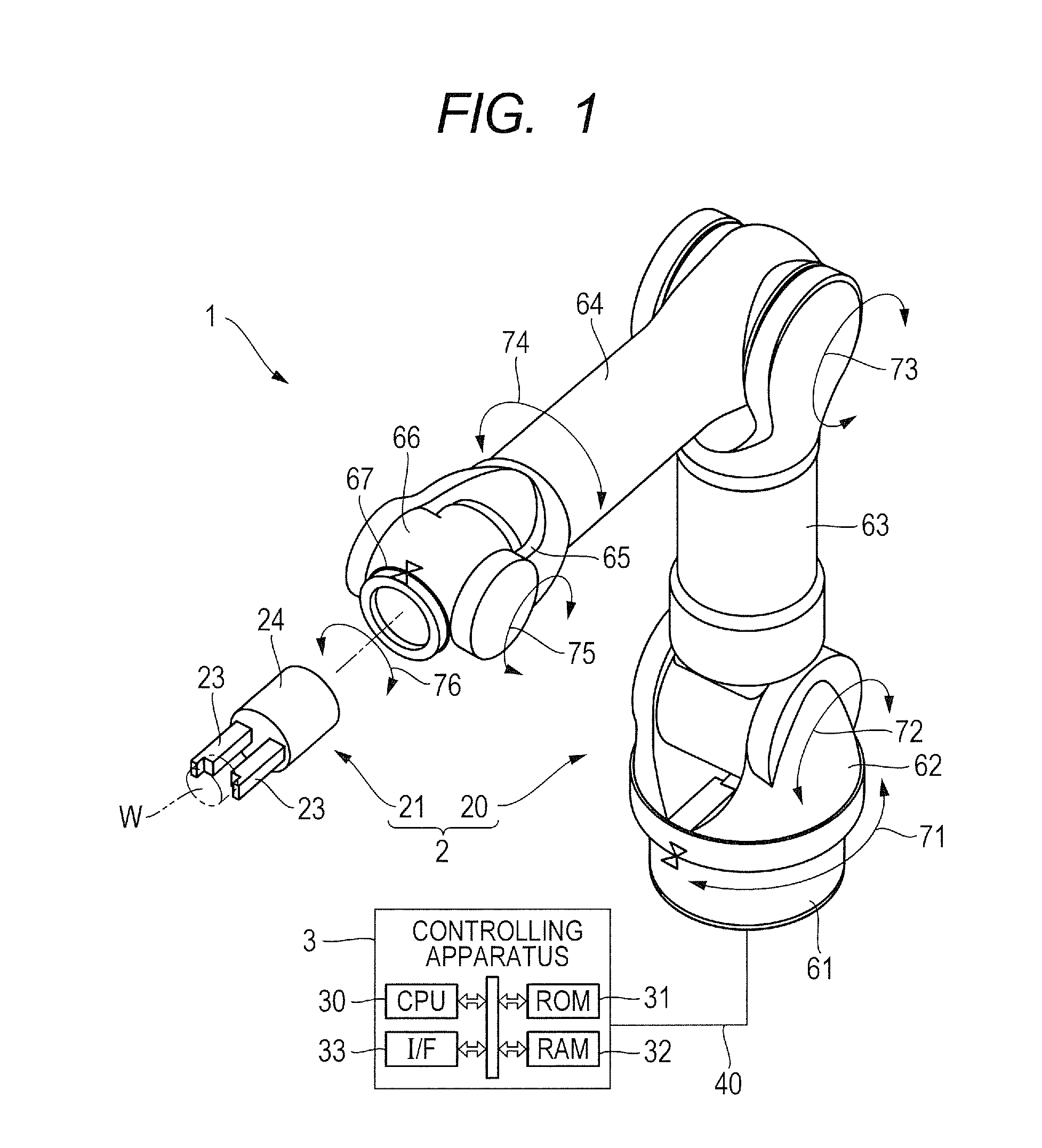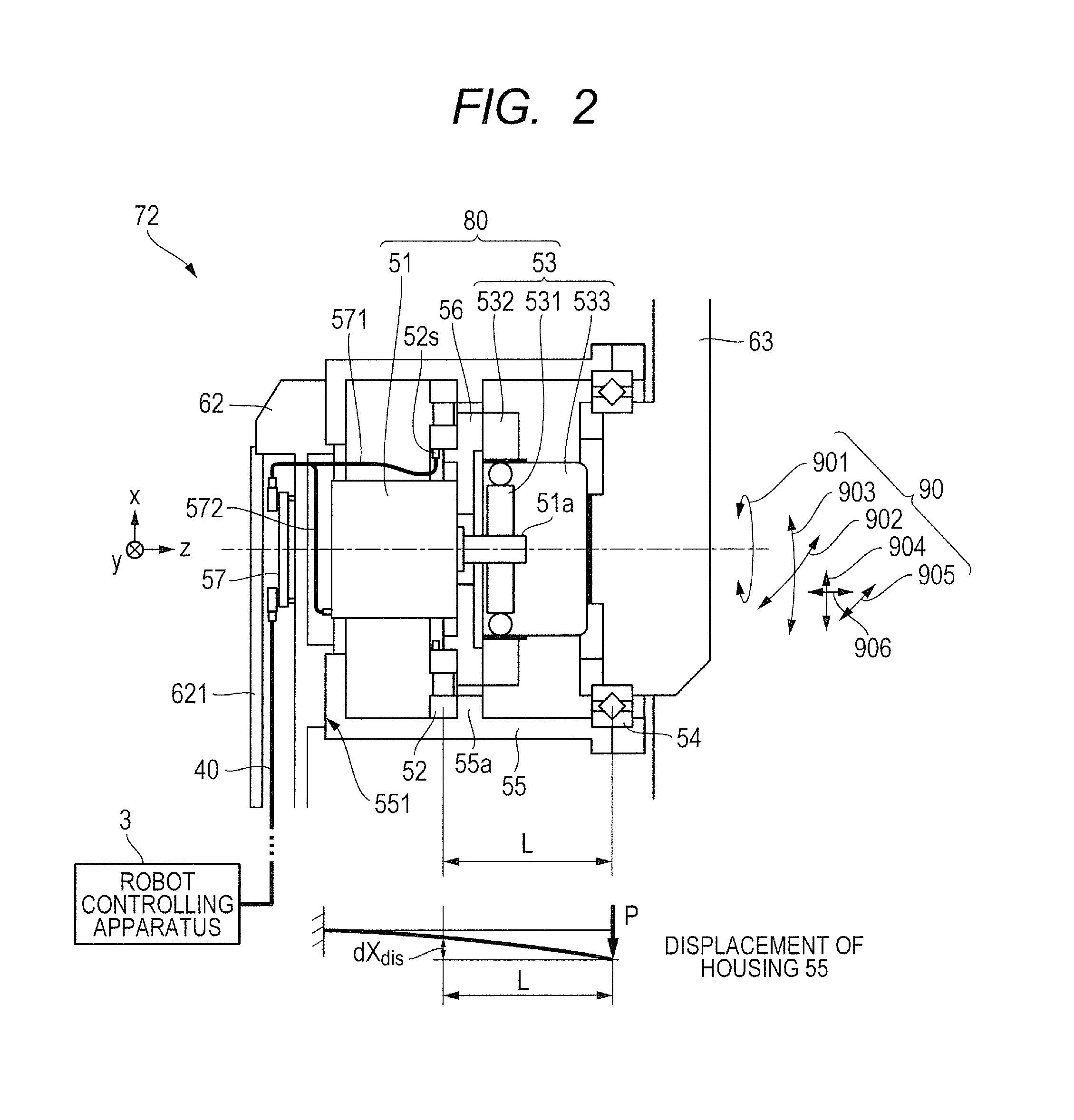Joint driving apparatus and robot apparatus
a technology of joint driving and robots, applied in the field of joint driving apparatus, can solve the problems of difficult to ensure the durability of sensor cables, difficult to accurately detect torque, complicated cable routing mechanisms, etc., and achieve the effect of high accuracy, accurate and reliable joint torque control, and measurement of joint driving torqu
- Summary
- Abstract
- Description
- Claims
- Application Information
AI Technical Summary
Benefits of technology
Problems solved by technology
Method used
Image
Examples
first embodiment
[0030]As shown in FIG. 1, a robot apparatus 1 includes a robot body 2 and a controlling apparatus 3 adapted to control the robot body 2. The robot body 2 is equipped with a hand 21 as an end effector in a front end portion of, for example, a six-axis vertical multi-joint robot arm (hereinafter, referred to as an arm) 20. The arm 20 includes seven links 61 to 67 and six joint driving apparatus 71 to 76 adapted to swingably or pivotably couple together the links 61 to 67.
[0031]The hand 21 is supported by being attached to a foremost link 67 of the arm 20 and is configured such that motion (changes in position and orientation) or a force of the hand 21 will be adjusted by movement of the arm 20. The hand 21 includes a hand body 24 and plural fingers 23 disposed movably with respect to the hand body 24 and configured to be able to grip a workpiece W.
[0032]The controlling apparatus 3 includes a CPU 30 made up of a general purpose microprocessor and the like. The CPU 30 controls movement ...
second embodiment
[0090]As shown in FIG. 2 and Expression (3), it can be seen that the deformation amount of the outer ring portion 5211 of the elastic body 521 of the torque detection apparatus 52 is affected greatly by the distance L between the installation location on the housing unit 55 and the bearing 54 supporting the joint. Thus, if the torque detection apparatus 52 (elastic body 521) can be placed close to the bearing 54, an amount of cross-axis interference can be reduced further.
[0091]For example, as shown in FIG. 3, the flange portion 55b used to attach the torque detection apparatus (elastic body 521) to the housing unit 55 is placed closer to the bearing (joint support mechanism) 54 than the flange portion (55a) in FIG. 2. Then, the torque detection apparatus 52 (elastic body 521) is mounted between the fixing portion 532 of the reduction mechanism 53 and the flange portion 55b. The rest of the configuration is similar to FIG. 2.
[0092]In the configuration of FIG. 3, the torque detection...
third embodiment
[0094]In the embodiments described above, the elastic body 521 of the torque detection apparatus 52 has been shown as having an annular shape (ring shape) by example. However, the joint driving apparatus (72) may be configured as shown in FIG. 4 using the torque detection apparatus 52 which employs an elastic body of different shapes such as shown in FIGS. 7 to 9.
[0095]The present embodiment uses a torque detection apparatus 52 such as shown in FIG. 7. The torque detection apparatus 52 includes an elastic body 521, an exterior member (cover) 522 configured to protect the elastic body 521, and a sensor cable 571 and has an approximately cylindrical shape as a whole.
[0096]As shown in FIG. 8, the elastic body 521 includes a flange 5211a serving as a first fixing portion and a flange 5212a serving as a second fixing portion. The flanges 5211a and 5212a are joined together by an elastically deformable portion 5213 cylindrical in shape, and are united into a cross-sectional shape such as ...
PUM
 Login to View More
Login to View More Abstract
Description
Claims
Application Information
 Login to View More
Login to View More - R&D
- Intellectual Property
- Life Sciences
- Materials
- Tech Scout
- Unparalleled Data Quality
- Higher Quality Content
- 60% Fewer Hallucinations
Browse by: Latest US Patents, China's latest patents, Technical Efficacy Thesaurus, Application Domain, Technology Topic, Popular Technical Reports.
© 2025 PatSnap. All rights reserved.Legal|Privacy policy|Modern Slavery Act Transparency Statement|Sitemap|About US| Contact US: help@patsnap.com



